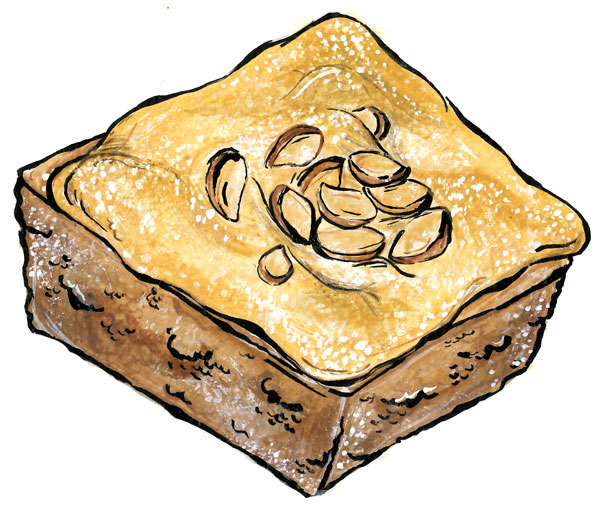If I had to choose a last breakfast, I’d choose a bostock. It’s like French toast you eat out of hand: one that’s rich and nutty, toasty but bright with citrus, and just sweet enough.
Bostock and French toast share some history.
Bostock first showed up in France in the 1930s. Like the classic French toast we know in the states, bostock was a way to use up leftover day-old bread—in this case, rich, sweet, buttery brioche. But instead of a wet, eggy slice that’s seasoned with cinnamon and drenched in maple syrup, brioche is scented with orange and almond. Funny enough, even though bostock was developed as a way to make use of an old product instead of selling it out, you’ll have trouble finding it at your average French corner bakery, even in Paris. Instead, you’ll find bostock in Paris’s fancy, jewel box pastry shops, like Pierre Hermé and Ladurée.
At Zingerman’s Bakehouse, the master pastry bakers have been making bostock for a decade and a half using the traditional flavors and technique—with one exception. Zingermans bostock is so popular that it’s not a way to use up day old brioche; instead, they bake loaves and loaves of brioche just to make bostock. They cut the square loaves into thick slices—each about an inch and a half tall. They dip each slice in orange syrup. Next comes a generous layer of frangipane, a custardy almond cream made with almond paste, more whole roasted almonds ground until smooth, sugar, butter, eggs, and a smidge of salt. They sprinkle a few slivered almonds on top, and then it goes into the oven to bake.
Bostock is toast gone luxe.
When you eat a bostock, start with the crust around the sides. It’s a little darker, and has a slightly deeper, toastier flavor. The almond frangipane often dribbles over the edges and down the sides just a tad, and it adds a sweet, nutty richness. Eating the sides first saves the best for last: the center. The middle of the bostock really soaks up the orange syrup, so the fluffy brioche becomes moist and toothsome. Bright citrus notes harmonize with sweet, nutty almond. It’s an ideal start to a weekend morning, or a luscious treat for an afternoon pick me up. Because a bostock is fairly sweet, I pair it with a more bitter drink—a macchiato rather than mocha, or Earl Grey tea rather than a chai latte. Though they’re tasty at any temperature, they can be especially lovely after a few minutes warmed to crisp up the edges.
Bostock wins the title of Staff Favorite New Pastry of the Decade, hands down.
It’s not often that we bring on a new pastry at Zingerman’s Mail Order—maybe two or three times a year, tops. Usually when we do, it takes a little time for everyone to have a chance to taste it, to learn about it, and to come to love it. With bostock, though, there was no delay. Time and again, when I mentioned to someone that we were going to start selling bostock, their eyes lit up. “Oh!,” they’d exclaim, “I love bostock! It’s my favorite pastry from the Bakehouse.”
Bostocks are light and a bit delicate, so we don’t ship them on their own. As of this spring, though, they’re in a slew of our gift boxes and baskets—including our custom pastry sampler boxes, where you can choose to fill up the whole box with a mix of treats… or all bostocks.

